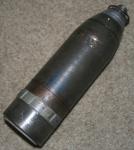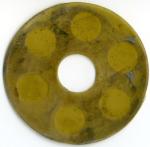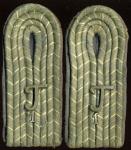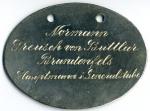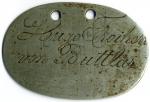-
Posts
2,962 -
Joined
-
Last visited
Content Type
Profiles
Forums
Blogs
Gallery
Events
Store
Everything posted by Chip
-
Dave, Nice buttons. At 23mm where would these have been worn on a Bluse? Pocket and shoulder strap buttons would most likely have been in the 18mm size. Perhaps these would have been the tunic buttons during that 1915 period when the painted steel buttons were first coming into use. That might also account for their scarcity, as these would only have been produced for a short period of time. What do you think? It would make sense that these buttons might have been worn on an overcoat, but I have never heard that there was any deviation from the 1915 universal crown buttons for any branch or contingent. Anybody out there have additional information? Would any tropical uniforms had such a wartime button? Middle Eastern contingents? Chip
-
Robert, These are some nice photos. The collar insignia in the last photo is that of the 8.bayr.Res.Div. This was one of a handful of German unit pins that were allowed to be worn. This was never officially sanctioned, but it was widely worn and I have seen a six foot tall version of this same insignia being displayed at a Lager. Chip
-
Jens, Thanks for the pictures of the fuses. Here is a look at the entire round. Unfortunately, the glare from the flash has obscurred some of the detail. The body is painted in the same color of Feldgrau as a trench helmet. The "N"s are stencilled on in dark blue paint. It also appears that there were once four red vertical painted stripes on the fuse. These have mostly flaked away, but you can see a remnant of the red in my earlier picture of the fuse. Chip
-
Jens, Thanks. It really is a nice example with most of the original paint. The fuse is dated 1918. Not sure what the threads on the tip of the fuse are for. Is it missing some sort of cap? Do you know? Chip
-
Jens, There is only the single wafer. The outside diameter is 60mm and the diameter of the inner hole is 15mm. There are no markings that I can see. I don't think that I will be trying to light it! Glad to help. Here are a few shots of my Nachrichten round. Chip
-
Jens, Here is a wafer that I found inside the propellant chamber on the bottom of my round. It looks like old cellulose film, very thin and yellowed. The inner circles match the holes of the bottom cap and might just be impressions from being rested on the cap for so many years. Could this be some sort of solid propellant? Chip
-
That light Minenwerfer auf Lafette must be in Brussels. It sure looks familiar. Chip
-
Jens, Very nice that you could recontruct this piece. I especially admire you getting the fuse apart. A large number of medium Minenwerfer fuses were found and appeared here on the collector market in the 1980s. Unbeknownst to everyone handling them, they were still live and the gains were full of powder! A well known militaria auction house had one in storage waiting for sale and it somehow ignited starting a fire. These were brass M.u.S.W.M.Z. produced by Rhein Metal, dated 1917. They are still around in collections, so if you see one, take care. I have a round similar to yours, which was captured during the war and sent back to the States as war booty by the government. Over the years I have seen several of these Nachtrichten rounds. They are painted Feldgrau and have zinc driving bands and combination zinc/aluminum fuses. They have four dark blue stencilled letter "N" painted around the body of the shell. The fuse is marked "L.W.M.Zdr.2." and dated "1918". Inside is a capsule with a protected compartment for the message. I have searched in vain for years to find an H.E. round such as the one you have. Nice job! Chip
-
Paul, The F?silier Rgt. Nr.40 would have adopted white as the backing color in 1915, but epaulettes and the epaulette bridals were abolished at the same time, so these epaulettes are confusing to me. Prior to September 1915 the shoulder straps of F.R.40. were Hellblau (a medium blue). The cuff Patten for the regiments of the XIV Army Corps had no piping. There was no official "transitional" Dunkelblau tunic, though we know from photographic evidence that these uniforms were worn at home in Germany up until the end of the war. I rather doubt that new blue uniforms were being made after 1915. So at best, this has to be a pre-1916 made tunic, which would not be correct for F.R.40. I would really appreciate it if someone would explain the epaulettes to me. I must be missing something, as they appear to be OK from what I can see. Chip
-
Very interesting to me-- he has chosen the expense of buying a single Bavarian style ribbon bar for his EK2... rather than just wearing it in his buttonhole! What buttonhole! Here are what a pair officer's boards from the same unit look like. The Bavarians used the Prussian style "T" until 1918 when they changed to this rather plain "T" design for the officer's insignia. These are the only examples that I have seen of this pattern and Robert's photo is the first I have seen of it being worn. Chip
-

WW1 canteens
Chip replied to Chris Boonzaier's topic in Germany: Imperial Uniforms, Headwear, Insignia & Personal Equipment
Mike, No, I am not saying that at all. The canteen is definitely German. It is hard to tell about the cover with such a photo. The fact that it was used by a reenactor gives it that worn look. Most things like this can only be judged by a first-hand inspection. Chip -

WW1 canteens
Chip replied to Chris Boonzaier's topic in Germany: Imperial Uniforms, Headwear, Insignia & Personal Equipment
Hun Helmet, The cover looks as if it might have had a button for attaching the stopper strap. If that is the case, the cover is for the 1917 pattern canteen. The canteen itself was unchanged from the M1915. Only the cover was altered in order to use less leather than the 1915 pattern which had a longer strap. Chip -
Christian, They look like the 1866 pattern boards, but there is not much reference about them. I'm sure that the "C" was still being used at that early time, but later became a "K". The colors look Hessian. This is all just pure speculation. Perhaps others have more details about the possibilities from that era (pre 1888). Chip
-
Tony, I don't think that there is any way to get the corrosion off of these zinc disks without doing damage. Best bet is just to try to stop the further deterioration. I wash them with a mild dish soap (like Dawn, which has degreasing properties), then let them dry. When dry, I coat them with Vaseline and then wipe the excess off. This darkens them up a little bit and the non-sticky film helps to keep further moisture out. Chip
-

WW1 canteens
Chip replied to Chris Boonzaier's topic in Germany: Imperial Uniforms, Headwear, Insignia & Personal Equipment
Mike, The canteen looks fine. When you get it, there is a good chance that you will find some marking on it. These were often marked either with an ink stamp or a brazed-on piece of metal with the manufacturer's name and a date. Chip



